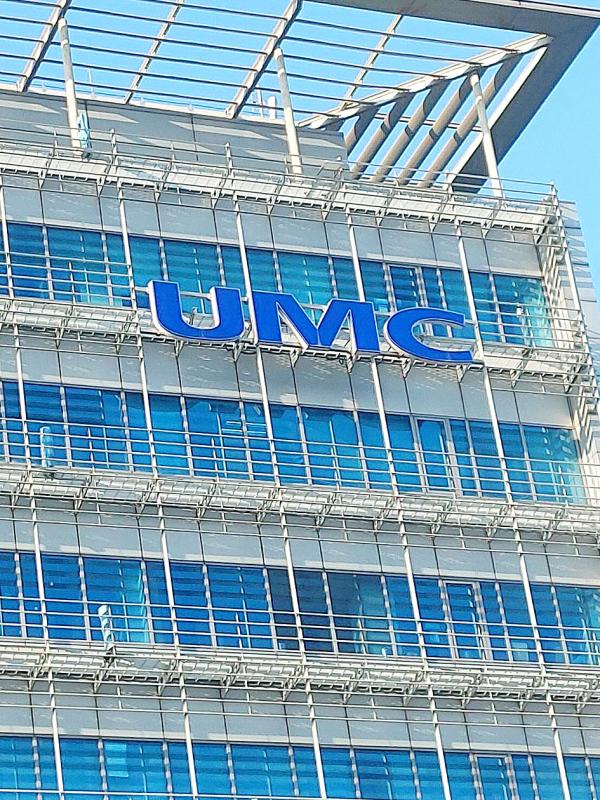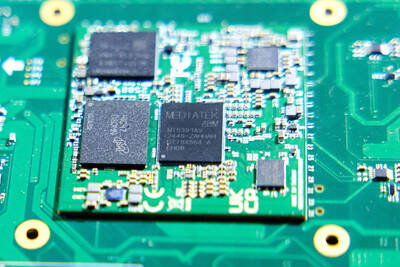United Microelectronics Corp (UMC, 聯電), the world’s third-largest contract chipmaker, saw its net profit grow almost 3-folds last quarter, thanks to robust chip demand for consumer electronics and computing-related applications.
Net profit surged to NT$11.2 billion (US$394.64 million) during the final quarter last year, compared with NT$3.84 billion in the same period of 2019. On a quarterly basis, net profit jumped 171 percent from NT$9.11 billion, UMC said yesterday.
For the full year of last year, net profit expanded 200 percent to NT$29.19 billion, from NT$9.71 billion. That translated into earnings per share of NT$2.42 last year, up from NT$0.82 in 2019.

Photo: Grace Hung, Taipei Times
Strong demand drove UMC’s factory utilization rate to 99 percent last quarter from 97 percent in the third quarter last year, the Hsinchu-based chipmaker told investors, adding that it expects the ratio to climb to 100 percent this quarter.
The firm can add a mere 3 percent more wafer capacity this year, primarily from 12-inch fabs, UMC copresident Jason Wang (王石) told a teleconference.
Demand for 8-inch wafers and some 12-inch wafers has outpaced capacity growth, Wang said.
The company said it expects 28-nanometer capacity to expand 20 percent this year, with revenue contribution climbing to about 25 percent from 14 percent last year.
UMC is open to new merger-and-acquisition opportunities to expand capacity, Wang said.
Asked about a shortage of auto chips, he said that UMC is “trying its best to mitigate the shortage.”
“We have been doing that since the beginning of this year,” he said. “Looking into the first quarter, stable demand will lead to an incremental increase in wafer shipments and blended average selling prices in US dollar terms.”
UMC said that it expects chip prices to increase by 2 to 3 percent from last quarter in US dollar terms, while wafer shipments are to grow at a quarterly pace of 2 percent.
As supply constraints are likely to last for the next few quarters, chip prices would rise by 4 to 6 percent this year, it said.
Gross margin would expand to 25 percent this quarter from 23.9 percent last quarter, on the back of price hikes, UMC said.
However, the appreciation of the New Taiwan dollar against the US dollar would offset more than half of the implied growth projected for the current quarter, Wang said.
UMC “continues to share the foundry industry’s positive view for wafer demand” for this year, Wang said, adding that the company plans to spend US$1.5 billion on new equipment this year, up 50 percent from US$1 billion last year.

Leading Taiwanese bicycle brands Giant Manufacturing Co (巨大機械) and Merida Industry Co (美利達工業) on Sunday said that they have adopted measures to mitigate the impact of the tariff policies of US President Donald Trump’s administration. The US announced at the beginning of this month that it would impose a 20 percent tariff on imported goods made in Taiwan, effective on Thursday last week. The tariff would be added to other pre-existing most-favored-nation duties and industry-specific trade remedy levy, which would bring the overall tariff on Taiwan-made bicycles to between 25.5 percent and 31 percent. However, Giant did not seem too perturbed by the

Foxconn Technology Co (鴻準精密), a metal casing supplier owned by Hon Hai Precision Industry Co (鴻海精密), yesterday announced plans to invest US$1 billion in the US over the next decade as part of its business transformation strategy. The Apple Inc supplier said in a statement that its board approved the investment on Thursday, as part of a transformation strategy focused on precision mold development, smart manufacturing, robotics and advanced automation. The strategy would have a strong emphasis on artificial intelligence (AI), the company added. The company said it aims to build a flexible, intelligent production ecosystem to boost competitiveness and sustainability. Foxconn

TARIFF CONCERNS: Semiconductor suppliers are tempering expectations for the traditionally strong third quarter, citing US tariff uncertainty and a stronger NT dollar Several Taiwanese semiconductor suppliers are taking a cautious view of the third quarter — typically a peak season for the industry — citing uncertainty over US tariffs and the stronger New Taiwan dollar. Smartphone chip designer MediaTek Inc (聯發科技) said that customers accelerated orders in the first half of the year to avoid potential tariffs threatened by US President Donald Trump’s administration. As a result, it anticipates weaker-than-usual peak-season demand in the third quarter. The US tariff plan, announced on April 2, initially proposed a 32 percent duty on Taiwanese goods. Its implementation was postponed by 90 days to July 9, then

AI SERVER DEMAND: ‘Overall industry demand continues to outpace supply and we are expanding capacity to meet it,’ the company’s chief executive officer said Hon Hai Precision Industry Co (鴻海精密) yesterday reported that net profit last quarter rose 27 percent from the same quarter last year on the back of demand for cloud services and high-performance computing products. Net profit surged to NT$44.36 billion (US$1.48 billion) from NT$35.04 billion a year earlier. On a quarterly basis, net profit grew 5 percent from NT$42.1 billion. Earnings per share expanded to NT$3.19 from NT$2.53 a year earlier and NT$3.03 in the first quarter. However, a sharp appreciation of the New Taiwan dollar since early May has weighed on the company’s performance, Hon Hai chief financial officer David Huang (黃德才)